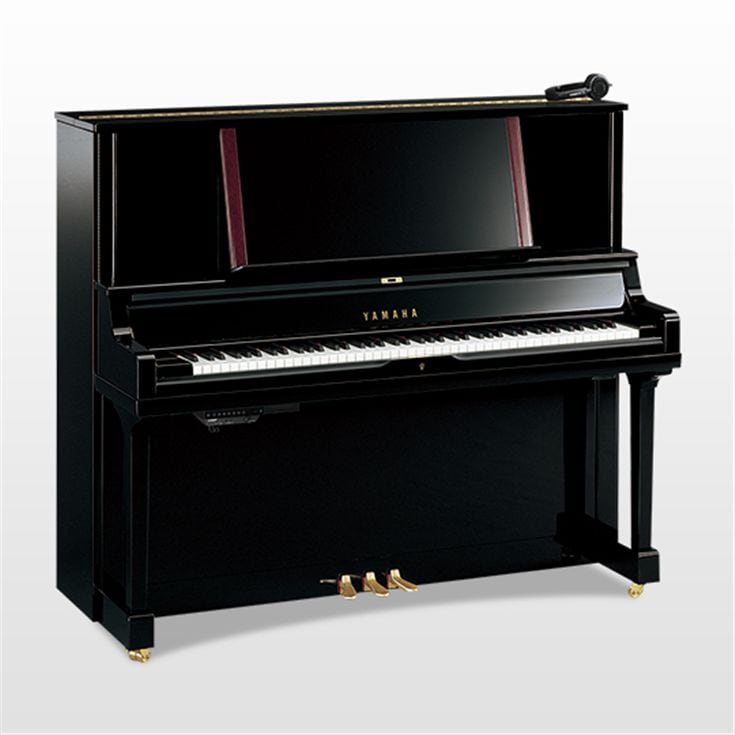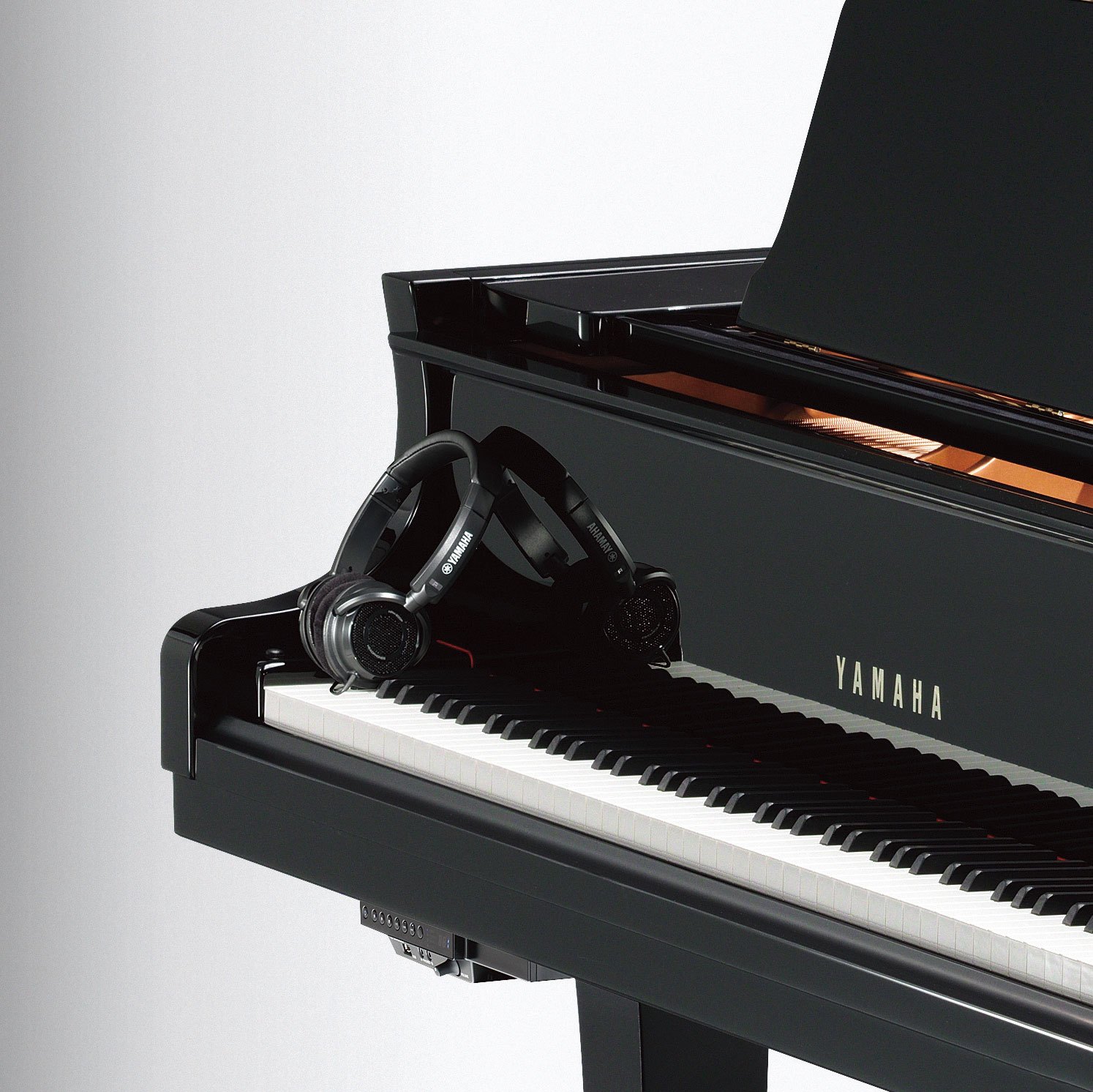A Yamaha Silent Piano is an acoustic piano with an option to play quietly using headphones. This feature allows for private practice without disturbing others.
Yamaha Silent Pianos merge traditional craftsmanship with modern technology, offering a tactile, responsive playing experience while maintaining neighborly peace. These pianos are equipped with a silent system that, when engaged, stops the hammers from striking the strings and instead captures the key movements digitally.
The player can then listen through headphones to digital sound emulations of a piano. This innovation is ideal for apartment dwellers or late-night practice sessions, ensuring the touch and feel of a grand or upright piano without the accompanying volume. With a Yamaha Silent Piano, pianists enjoy the best of acoustic and digital realms, facilitating practice and performance at any hour, respecting the peace of their surroundings.
The Genesis Of The Yamaha Silent Piano
Imagine playing a grand piano without waking your neighbors. This magic turned reality with Yamaha’s Silent Piano technology. It bridges tradition and modernity by combining the touch of a classic piano with the privacy of headphones. Let’s dive into the story of how this innovation reshaped piano playing forever.
Origins And Yamaha’s Innovation
Yamaha’s rich heritage dates back to the late 19th century. Known for crafting world-class acoustic pianos, Yamaha focused on enabling pianists to practice without limits. The need for a peaceful coexistence with family and neighbors fueled creativity.
- Founder Torakusu Yamaha established Yamaha in 1887.
- In 1900, they produced their first grand piano.
- Discovery: Musicians needed versatility in their practice.
In the 1990s, Yamaha unveiled a groundbreaking solution: the Silent Piano. This breakthrough combined traditional methods with digital ingenuity. By selecting the silent function, pianists could switch from acoustic to private listening seamlessly.
The Marriage Of Acoustic And Digital
At the heart of the Silent Piano lies a unique dual mode. When activated, it transitions from acoustic to a digital piano. This is not just about silence; it’s about flexibility and function.
| Acoustic Mode | Digital Mode |
|---|---|
| Traditional piano sound and feel. | Headphone use for silent practice. |
| Hammers strike strings producing music. | Digital samples mimic a piano’s sound. |
Yamaha’s Silent System features advanced sensors that detect keystrokes. It translates these into digital audio. The pianist can play at any time using headphones without disturbing others.
These pianos cater to both novice learners and professional maestros. The Silent Piano offers a unique practice environment day or night.

Credit: usa.yamaha.com
How The Silent Feature Transforms Practice
If you love playing piano, you might know how noise might be a concern. The Yamaha Silent Piano offers a great solution. This piano lets you practice any time without disturbing others. Let’s dive into how this feature changes practice times for pianists of all levels.
Engaging The Silent Mechanism
To use the silent feature, simply press a pedal or flick a switch on your Yamaha Silent Piano. This action stops the hammers just before they hit the strings. Instead, sensors detect your key presses and send the notes to your headphones. It’s like magic – you hear beautiful piano tones in full privacy!
Benefits For Quiet Environments
Using the silent mode brings many perks, especially in places where silence is golden.
- Night practice: Play at midnight, no worries!
- Living with others: Keep peace in your home, no loud music.
- Shared walls: Apartment living is easier; no noise complaints.
- Personal focus: Cut distractions, concentrate better.
- Parental bliss: Offer kids practice time without adding to your noise stress.
Technical Breakdown Of Silent Piano Technology
Yamaha Silent Pianos bridge the gap between acoustic richness and digital innovation. They offer the touch of a traditional piano while providing the option to play in silence. With Silent Piano Technology, a world of digital possibilities opens up. Let’s dive into how it works.
Understanding The Sensor System
At the heart of Yamaha Silent Pianos lies an advanced sensor system. This system detects every nuance of a player’s touch. Here’s how the sensor system brings silent pianos to life:
- Sensors under each key measure the speed and depth of key movements.
- These sensors capture the expressiveness of the player without producing sound.
- Hammer movements also have dedicated sensors.
- The system silently transmits data to the piano’s digital circuitry.
The Role Of Digital Sound Processing
Digital Sound Processing (DSP) is crucial in delivering high-quality audio through headphones. It does the following:
- Receives data from the sensor system.
- Uses advanced algorithms to generate authentic sound, mirroring acoustic playing.
- DSP allows players to hear themselves in complete privacy.
- It offers various sounds and effects, like concert hall reverb.
This innovative approach allows pianists to enjoy an intimate practice environment without compromising sound quality or playing experience.

Credit: www.rivertonpiano.com
Models And Variations In The Silent Piano Series
Yamaha Silent Pianos bridge traditional craftsmanship with modern innovation. These instruments allow pianists to enjoy the touch and tone of a conventional piano without disturbing others. The Silent Piano series comprises various models and variations. Each is designed to cater to diverse preferences and settings, from cozy practice spaces to spacious performance venues.
Comparing The Upright And Grand Models
Differences between upright and grand Yamaha Silent Pianos are significant in terms of size, shape, and sound projection. Here’s a quick comparison:
| Feature | Upright Models | Grand Models |
|---|---|---|
| Size | Compact | Expansive |
| Sound Projection | Vertical | Horizontal |
| String Length | Shorter | Longer |
Upright models, like the B1SG2 and U1SH2, are perfect for smaller spaces. In contrast, grand models, such as the GC1SH2 and C3XSH, offer unparalleled richness suitable for larger rooms or concert halls.
Special Features Across Different Series
- Digital Technology: Integrates cutting-edge sound muting capabilities while maintaining acoustic quality.
- Recording Function: Allows musicians to capture performances for later analysis or sharing.
- Connectivity: Includes options like MIDI and USB for interfacing with other digital tools and devices.
- Voices: Features diverse instrument sounds, enhancing practice sessions and performance versatility.
- Binaural Sampling: Provides a natural, three-dimensional sound experience when using headphones.
Series like the SH2 and SC2 also boast Smart Pianist app compatibility. This sync allows for intuitive control over the piano’s silent functions and additional features.
Professional And User Perspectives
Exploring the impact of Yamaha’s Silent Piano from diverse viewpoints offers invaluable insights. Hear from professionals who perform on the world stage and users who have brought this innovative instrument into their homes.
Endorsements By Renowned Pianists
The Silent Piano bridges the divide between traditional acoustics and modern technology. Famous pianists often endorse these pianos for their authentic touch and expression. Names like Elton John and Sarah McLachlan come to mind.
These artists relish the piano’s ability to switch from acoustic to silent modes. It offers the perfect blend of privacy and performance. They praise its realistic hammer action, which emulates a concert grand piano. Moreover, the cutting-edge digital features enhance practice and recording sessions.
Consumer Experiences And Reviews
For the everyday user, feedback is overwhelmingly positive. The Silent Piano’s versatility shines in online reviews. Users love the freedom to practice anytime without disturbing others. Parents appreciate the headphone option, ensuring their child’s practice doesn’t disrupt the household.
- Sound quality maintains the richness of an acoustic piano.
- Users highlight the ease of recording and compatibility with apps.
- The elegant design becomes a centerpiece in any room.
- Long-term investment thanks to robust build and quality materials.
Beginners and advanced players alike rave about the Silent Piano. The blend of traditional piano feel with the perks of digital features strikes a chord with users. The Silent Piano not only meets but exceeds expectations.

Credit: usa.yamaha.com
Integrating Silent Pianos Into Learning And Performance
The Yamaha Silent Piano bridges the gap between tradition and innovation. Music students and professionals embrace its versatility for various settings, from quiet practice to live recording. Explore how silent pianos enhance musical journeys.
Advantages In Music Education
Silent Pianos revolutionize learning for budding musicians. Teachers endorse them for their ability to foster focused practice without disturbing others.
- Students can practice at any time, minimizing disruptions in the household.
- Headphones enable immersive learning, helping students concentrate.
- Silent pianos provide a safe space for mistakes, boosting confidence.
- Instant feedback on play is possible through digital features.
Utilizing Silent Pianos In Recording Sessions
In recording environments, Silent Pianos show their true colors.
Artists get high-quality sound without outside noise. Tracking sessions become seamless. Technicians appreciate the ease of use.
- Connect directly to recording equipment for crystal-clear sound capture.
- Musicians can record with headphones, ensuring zero external noise.
- Versatile connectivity options make setup quick and easy.
Is a Yamaha Silent Piano and Electric Piano the Same Thing?
No, a Yamaha Silent Piano and an electric piano are not the same thing. While an electric piano is a digital instrument that replicates the sound of a traditional piano, a Yamaha Silent Piano is an acoustic piano with an integrated digital system for silent practice. Each has its own unique electric piano overview and features.
Frequently Asked Questions Of What Is A Yamaha Silent Piano
How Does Yamaha Silent Piano Work?
Yamaha Silent Pianos combine traditional acoustic action with digital technology. Engaging the silent function mutes the strings, allowing for quiet headphone practice without disturbing others. Digital sound is generated, reflecting the acoustic tone and touch.
What Is The Difference Between A Silent Piano And A Normal Piano?
A silent piano allows for private practice with headphones, while a normal piano always produces audible sound when played. Silent pianos combine traditional action with digital sound muting capabilities.
What Is The Point In A Silent Piano?
A silent piano combines traditional acoustic piano mechanics with a muting feature, allowing for quiet practice with headphones.
What Is The Best Silent Piano?
The Yamaha Silent Piano Series is often rated as the best for combining traditional touch with silent practice options.
Conclusion
Exploring the world of piano innovation, Yamaha Silent Pianos stand out. They blend traditional touch with modern muting technology, ideal for any time practice. Perfect for budding and seasoned pianists alike, these instruments are a sound investment. Embrace the freedom of playing without disturbing others, thanks to Yamaha’s ingenuity.
